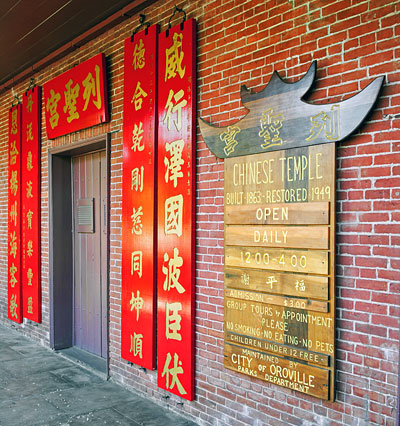National Register of Historic Places in Butte County
Oroville Chinese Temple
1500 Broderick Street
Oroville
Built 1863
The Oroville Chinese Temple is comprised of three buildings: the main temple with attached Chan Room, the Tapestry Hall, and a two-story building containing both the Council Room and Moon Temple.
Architecturally, the temple grouping forms a unique complex, combining architectural design elements of both eastern and western cultures. The simplicity of decorative elements of the structures reflects the constraints of early California pioneer life.
The Main Temple is similar in style to numerous structures of the Gold Rush era in this vicinity. The structure has classic design origins but is essentially stripped of the decorative elements that traditionally accompany that style. The false front parapet with flattened pediment suggests its classic origins, as do the flat arches of brick over the building entrances. The porch or portico is supported by two simple wood columns that flank the entryway. In this country, particularly in the south, classic and Greek revival styles are often accompanied by open porticos and loggias.
The temple is a unique survivor of the Chinese community that thrived in Oroville during the early years of California statehood. A portion of the complex was completed in 1863 when there were an estimated 10,000 Chinese located in the Oroville area. Although these Chinese came to America with little material wealth, they brought their strength, bravery, industry, and the rich heritage of the civilization they left behind.
This heritage was embodied in the Oroville Temple which became the religious, business, and social center of the Chinese community. It remained the center of importance until the 1920s and 1930 when difficult economic times and racial strife forced many Chinese residents to migrate out of the area.
At the present time (1976), many Chinese still come to worship according to the tradition of Taoism, Confucianism, and Buddhism.
Since 1959, the Temple Complex has been open to the general public as a museum dedicated to Chinese culture and tradition.
Excerpted from the NRHP Nomination.


Taoist Temple in Hanford
Bok Kai Temple in Marysville
Kwan Tai Temple in Mendocino
Chinese Temple in Oroville
Joss House in Weaverville
